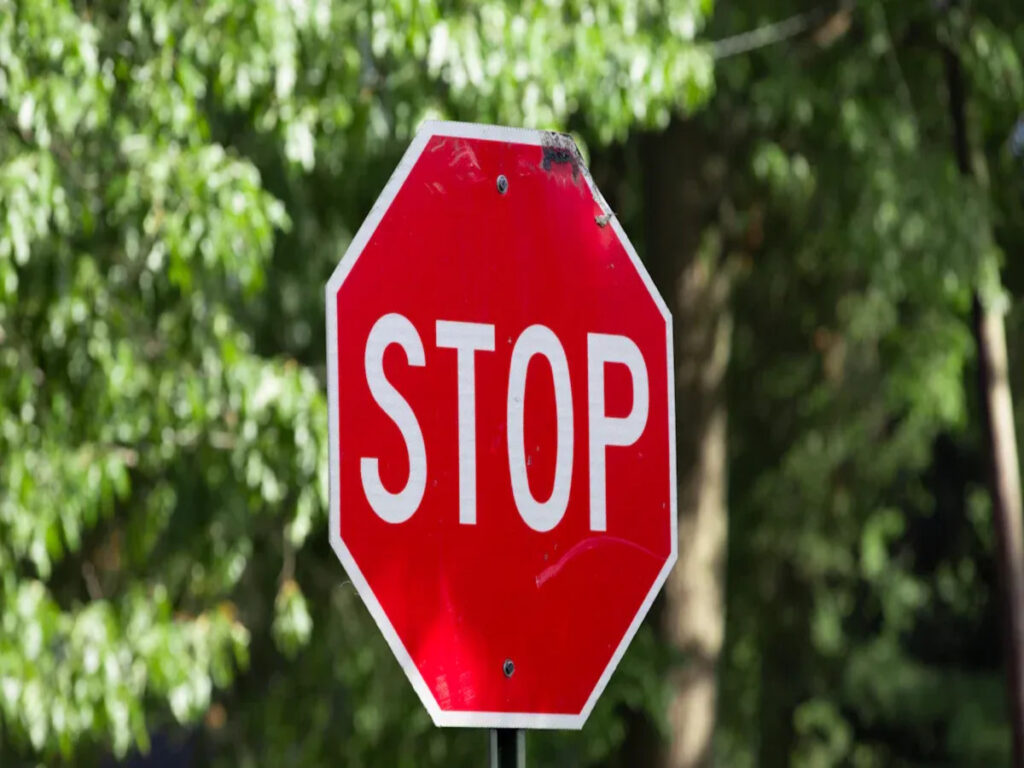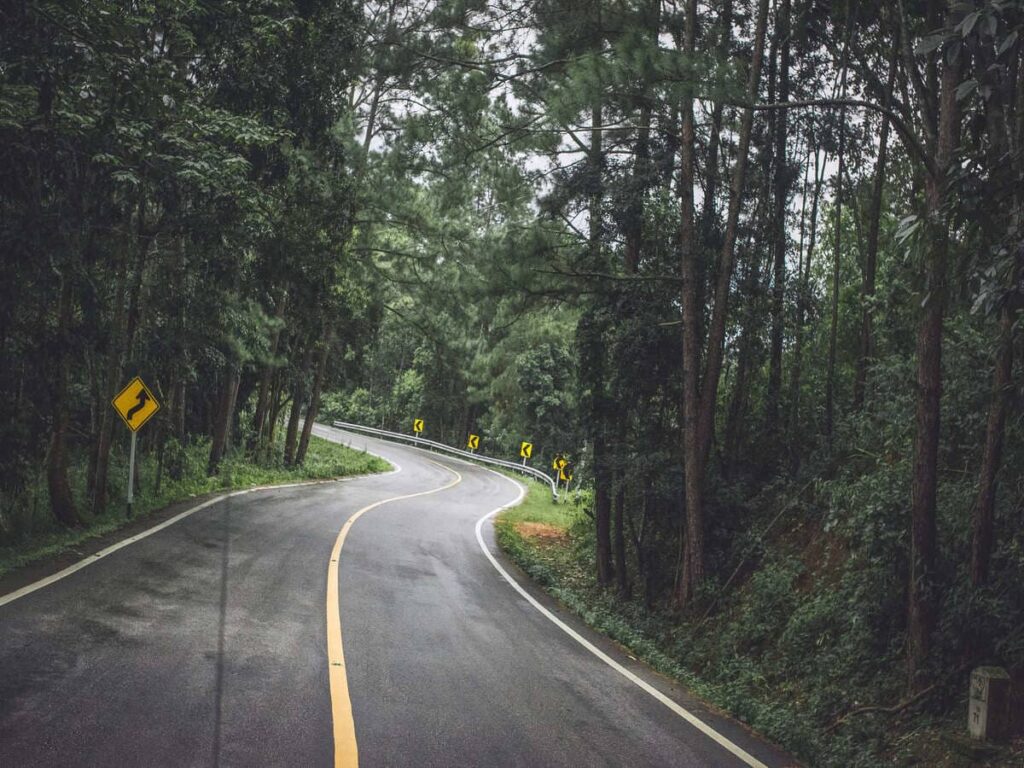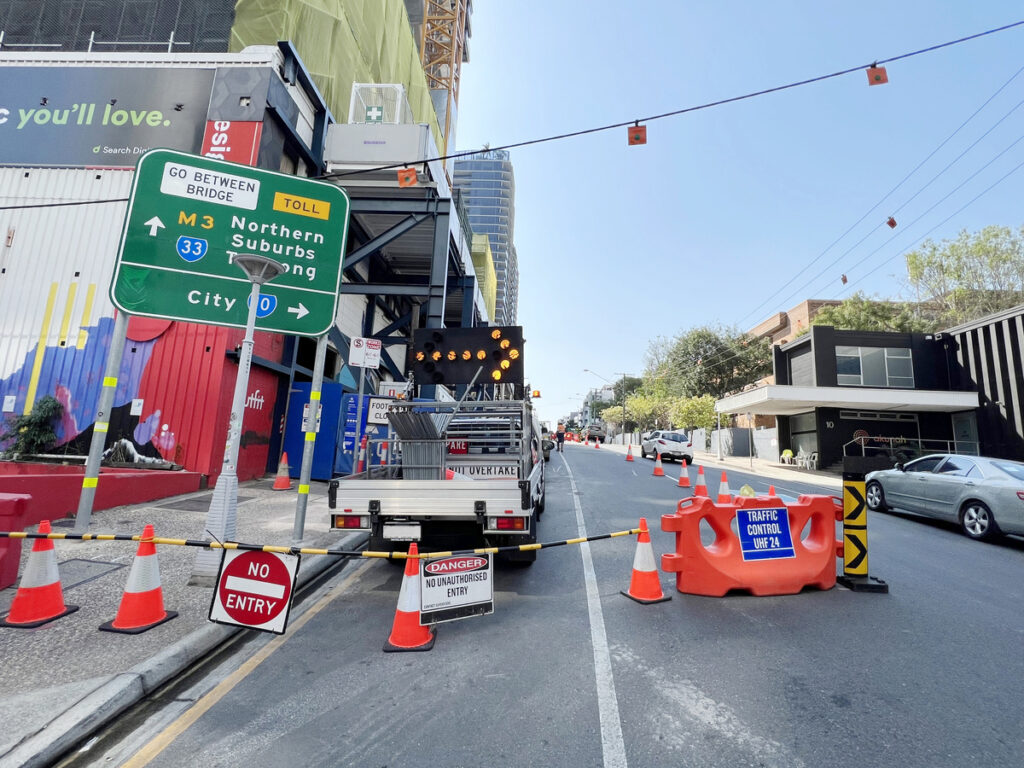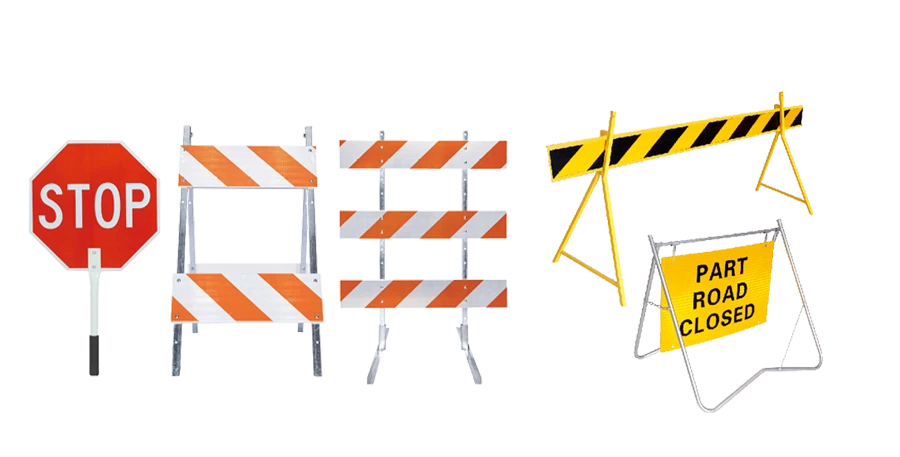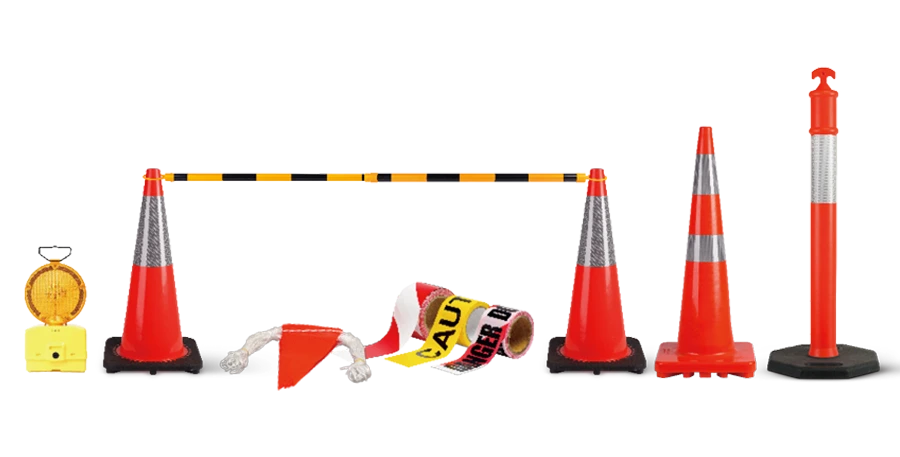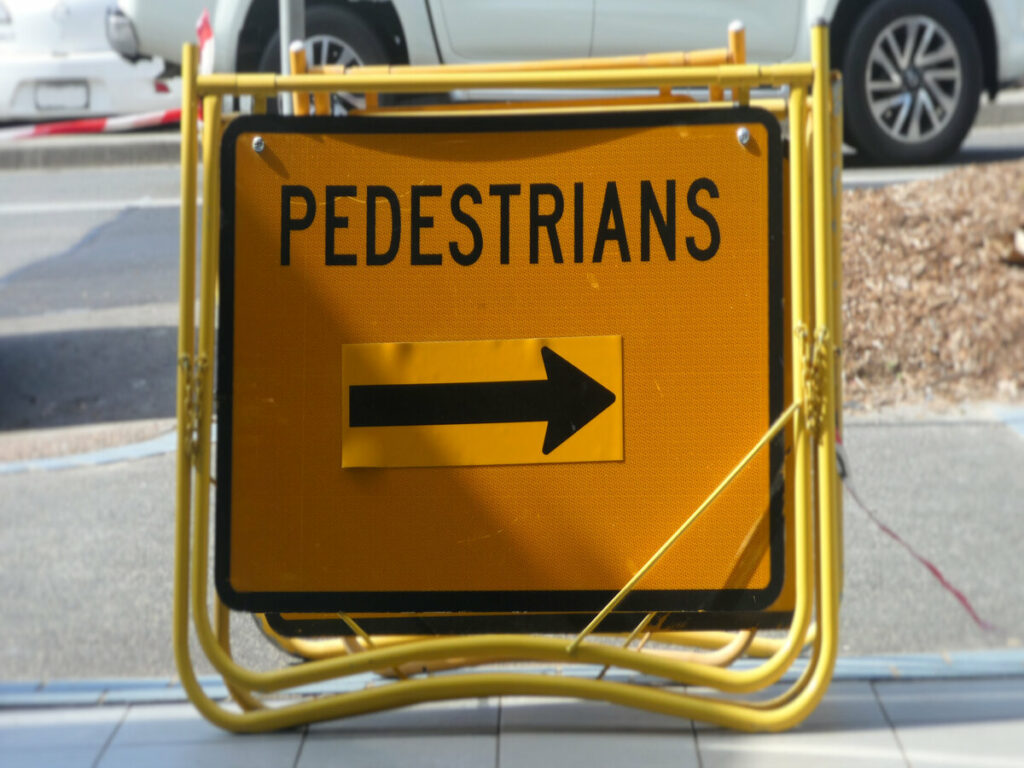
عند اختيار إطارات علامة التأرجح, ركز على سعة التحميل وتناسب اللوحة. هذه تساعد في الحفاظ على الإطار ثابتًا ويعمل بشكل جيد. إذا لم يتطابق الإطار واللوحة, قد يؤدي أو يكسر. هذا محفوف بالمخاطر, خاصة على الطرق الأسترالية المزدحمة. طقس, رياح, ونوع الأرض يؤثر أيضًا على كيفية عمل الإطار. على سبيل المثال, قد لا يتعامل إطار جيد لسيدني مع رياح بيرث الساحلية القوية. إن معرفة هذه العوامل تساعدك على اختيار خيارات أكثر أمانًا وأفضل.
أوبترافيك يقدم مجموعة كاملة من إطارات علامة الأرجوحة والمطابقة لوحات التوقيع- مصمم للتعامل مع الظروف الأسترالية المتنوعة من شوارع سيدني إلى رياح بيرث الساحلية. فريق خبراء OPTRAFFIC موجود هنا لمساعدتك في اختيار مجموعة علامات الإطار المناسبة لمشروعك, ضمان السلامة, متانة, وتناسب مثالي في كل مرة.
اتصل بنا اليوم للحصول على توصيات مخصصة والحصول على أفضل إعداد لموقعك.
الوجبات الرئيسية
- اختر إطارات اللافتات المتأرجحة التي تتوافق مع حدود الحمولة وحجم اللوحة من أجل السلامة.
- تحقق من حدود التحميل الخاصة بالشركة المصنعة وجرب الإطارات في الإعدادات الحقيقية أولاً.
- استخدم قواعد عريضة ومشابك متينة لتحقيق الثبات في الأماكن العاصفة مثل بريسبان وبيرث.
- قم بفحص إطارك وإصلاحه كثيرًا لتجنب التلف والحفاظ عليه لفترة أطول.
- اختر المواد التي تناسب الطقس في منطقتك لجعلها أقوى وأكثر أمانًا.
فهم سعة التحميل
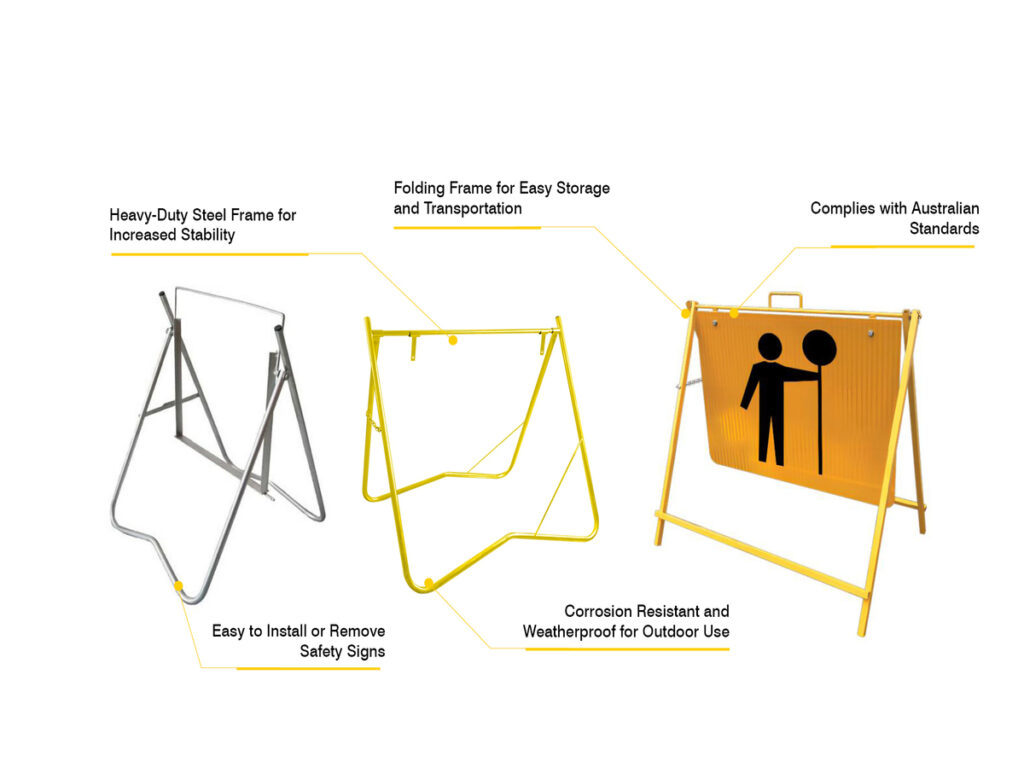
الحد الأقصى لحجم اللافتة والوزن المدعوم
تحتوي إطارات اللافتات المتأرجحة على لوحات ذات أحجام وأوزان معينة. يجب أن يتناسب الإطار مع اللوحة لمنع الانقلاب أو الكسر. يعطي المصنعون قواعد لأكبر الألواح والأوزان المسموح بها. على سبيل المثال, إطارات تحت مثل 4100 المعايير يمكنها حمل ألواح بحجم 600×600 مم 5 كجم أو وزن 900×900 مم 8 كجم.
حجم أنبوب الإطار, قوة المشبك, ويؤثر عرض الساق على حد الحمولة. الأرجل العريضة تجعل الإطارات أكثر ثباتًا, خاصة في الأماكن العاصفة مثل بريسبان أو بيرث الساحلية. في حالة استخدام لوحات أكبر, اختر إطارات ذات مشابك أقوى وأنابيب أكثر سمكًا للتعامل مع الوزن الزائد.
تقييمات الشركة المصنعة تحت AS 4100 المعايير
يتبعه صناع أستراليون مثل 4100 المعايير لصنع إطارات لافتة متأرجحة آمنة وقوية. تتحقق هذه القواعد من مدى جودة عمل الإطارات في ظروف مختلفة. يمكنك الوثوق بهذه التقييمات لاختيار الإطار المناسب لاحتياجاتك.
نصيحة: اقرأ دائمًا قواعد التحميل الخاصة بالشركة المصنعة قبل الشراء. اختر الإطارات التي تم اختبارها في ظروف الحياة الواقعية مثل الرياح أو الأرض غير المستوية.
تدعم الاختبارات هذه التصنيفات من خلال دراسة مواد مثل الفولاذ والألومنيوم. تُظهر المحاكاة كيف تتعامل الإطارات مع الضغط والوزن. تضمن فحوصات السلامة قدرة الإطارات على حمل أكثر من حمولتها المعتادة.
العوامل الرئيسية المؤثرة على سعة التحميل
تؤثر العديد من الأشياء على مقدار الوزن الذي يمكن أن تحمله إطارات اللافتات المتأرجحة. معرفة هذه الأمور تساعدك على الاختيار بحكمة:
- قوة المواد: تحمل الإطارات الفولاذية أو الألومنيوم الأحمال الثقيلة بشكل أفضل.
- تصميم المشبك: المشابك القوية تمنع الألواح من الانزلاق أو السقوط.
- انتشار الساق: أرجل واسعة توازن الوزن وتتوقف عن الانقلاب.
- الظروف البيئية: رياح, نوع الأرض, وتغير الطقس استقرار الإطار.
على سبيل المثال, أظهر اختبار كوينزلاند أن لوحة الألومنيوم مقاس 900 × 900 مم ظلت ثابتة 35 كم/ساعة الرياح على إطار تصنيف. يوضح هذا سبب أهمية اختيار الإطارات لطقس معين.
ملحوظة: اختبر الإطارات بالأوزان قبل استخدامها في الأحوال الجوية السيئة. استخدم أكياس الرمل للتحقق من الانحناء أو التذبذب.
دراسة حالة: قسم كوينزلاند. اختبار مجال النقل
ال وزارة النقل في كوينزلاند تم اختبار إطارات اللافتات المتأرجحة. لقد أرادوا أن يروا كيف تعمل الإطارات في الطقس القاسي. فحص الاختبار الثبات بألواح أكبر وهبوب رياح قوية.
إعداد الاختبار وشروطه
تم استخدام لوح ألومنيوم مقاس 900 × 900 مم للاختبار. تم وضعه على إطار حامل متأرجح مصنف تحت مثل 4100 المعايير. وشهد موقع الاختبار هبوب رياح تصل إلى 35 كم/ساعة, مثل تلك الموجودة في المناطق الساحلية في كوينزلاند. تم اختيار سطح مستو للحصول على نتائج واضحة.
البصيرة الرئيسية: ألواح الألمنيوم خفيفة ولكنها قوية. أنها تحظى بشعبية لإطارات الحامل المتأرجح. لكن, يعتمد أدائها على تصميم الإطار والحد الأقصى للوزن.
نتائج الاختبار الميداني
أظهر الاختبار نتائج مفيدة للمساعدة في اختيار إطارات أفضل:
- الاستقرار في ظروف عاصف: ظل الإطار ثابتًا أثناء الاختبار. أرجل واسعة ومشابك قوية تمنعه من الانقلاب في الرياح المفاجئة.
- توزيع الأحمال: ينتشر وزن اللوحة بالتساوي عبر الإطار. أدى هذا إلى تقليل الضغط على أجزاء مثل المشابك والمفصلات.
- أداء المواد: لم ينحني الألومنيوم أو يلتوي في ظل ظروف الرياح. وهذا يجعله خيارًا جيدًا للاستخدام في الهواء الطلق.
الآثار العملية للمشترين
يمكن أن تساعدك هذه النتائج في اختيار إطارات الحامل المتأرجح المناسبة:
- التركيز على الاستقرار: اختر إطارات ذات أرجل واسعة ومشابك قوية. تحافظ هذه الميزات على ثبات الإطارات في الأماكن العاصفة مثل بريسبان.
- التحقق من تقييمات المواد: اختر الإطارات التي تم اختبارها بألواح الألومنيوم. وهذا يضمن أنها تعمل بشكل جيد في ظروف مماثلة.
- قم بإجراء اختباراتك الخاصة: قبل الاستخدام, اختبار الإطار الخاص بك مع الرياح والوزن. استخدم أكياس الرمل للتحقق من التذبذب أو الانحناء.
نصيحة: بعد 24 ساعات من الاستخدام, فحص الإطار الخاص بك. ابحث عن المشابك السائبة أو الأرجل المنحرفة التي قد تسبب مشاكل.
توضح هذه الدراسة أهمية اختيار الإطارات لطقس معين. إن اتباع هذه النصائح سيساعد إطار الحامل المتأرجح الخاص بك على العمل بشكل جيد في الطقس القاسي في أستراليا.
توافق اللوحة مع إطارات اللافتات المتأرجحة
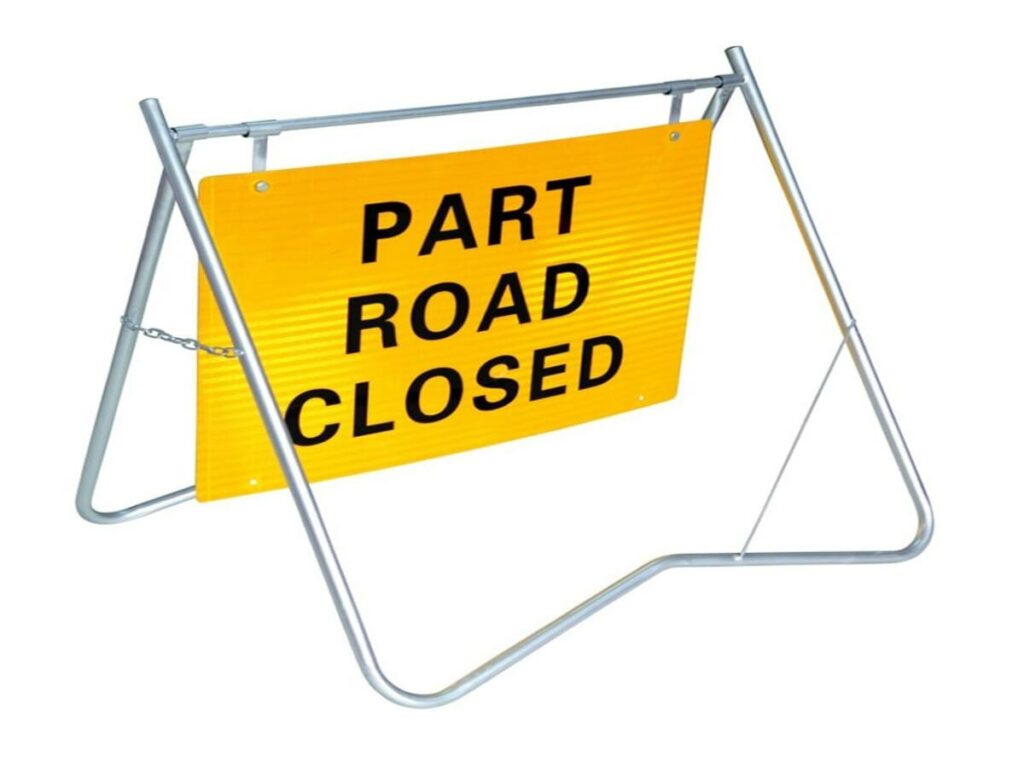
مطابقة سماكة اللوحة مع مشابك الإطار
يجب أن يتناسب سمك اللوحة مع حجم مشبك الإطار. وهذا يحافظ على أمان اللوحة ويمنعها من الحركة. معظم مشابك إطار اللافتات المتأرجحة تناسب اللوحات 1.2 مم ل 3 سماكة. استخدم مقياسًا محسوسًا لقياس سمك اللوحة بدقة.
لوحات رقيقة, مثل تلك الألومنيوم, قد تحتاج إلى دعم إضافي. يمكن للحشوات المطاطية تثبيت هذه الألواح بقوة دون التسبب في أي ضرر. كما أنها تقلل من الاهتزاز, الحفاظ على ثبات اللوحة في الطقس العاصف.
نصيحة: تحقق من حجم المشبك قبل شراء إطار علامة التأرجح. وهذا يتجنب المشاكل ويحافظ على اللوحة الخاصة بك في مكانها بأمان.
فتحات الفك القياسية وقياس سماكة الورقة
تحتوي إطارات اللافتات المتأرجحة على فتحات مشبك قياسية لأحجام اللوحات المختلفة. عادة ما تتناسب هذه الفتحات مع الألواح الموجودة بينها 1.2 مم و 3 سماكة. للتحقق مما إذا كانت اللوحة الخاصة بك مناسبة, قياس سمكها بعناية.
يعد مقياس المحسس أداة سهلة لقياس سماكة الورقة. قم بإدخاله في فكي المشبك لمعرفة ما إذا كانت اللوحة مناسبة أم لا. إذا كانت اللوحة رقيقة جدًا, قد يتمايل أو يتحرك. إذا كان سميكًا جدًا, قد يؤدي تشديد المشابك أكثر من اللازم إلى إتلاف الإطار أو اللوحة.
ملحوظة: لا تجبر الألواح السميكة على المشابك التي لا تناسبها. قد يؤدي ذلك إلى إضعاف المشبك وجعل الإطار غير مستقر.
تركيب ألواح الألمنيوم الرقيقة
ألواح الألومنيوم الرقيقة خفيفة ورائعة لإطارات اللافتات المتأرجحة. لكن نحافتها تعني أنها تحتاج إلى تركيب دقيق. تعتبر إدراجات الرقائق المطاطية مفيدة لهذه الألواح. إنها تحمي اللوحة من الخدوش وتمنعها من التحرك في الرياح أو الاهتزازات.
عند تركيب الألواح الرقيقة, لا تشديد المشابك كثيرا. يمكن أن يؤدي الضغط الزائد إلى ثني الألومنيوم وجعله أضعف. أحكم ربطه بما يكفي لتثبيت اللوحة بشكل آمن دون الإضرار بها.
الإطارات ذات المفصلات الفولاذية المطلية بالزنك مفيدة أيضًا. تتيح هذه المفصلات فتح الإطار حتى 180 درجة, مما يسهل ضبط اللوحة. أنها تعمل بشكل جيد مع العبوات 800 مم, 1000 مم, أو 1200 ملم واسعة, مما يتيح لك المزيد من الخيارات لأحجام اللوحة.
نصيحة: في حالة استخدام ألواح الألمنيوم الرقيقة, اختبر الملاءمة عن طريق هز الإطار بلطف بعد إعداده. يتحقق هذا من بقاء اللوحة ثابتة دون الضغط على المشابك.
تجنب الإفراط في تضييق الألواح السميكة
لوحات أكثر سمكا, مثل صفائح الفولاذ, قوية ودائمة. ولكن تشديد المشابك أكثر من اللازم يمكن أن يضر بهم. تعامل مع هذه الألواح بلطف لإبقائها في حالة جيدة. وهذا يساعد أيضًا إطار الحامل المتأرجح على العمل بشكل جيد.
لماذا يعتبر الإفراط في التشديد مشكلة
إذا تم تشديد المشابك بشدة, يمكن أن تحدث المشاكل:
- تشويه: قد تنثني اللوحة أو تفقد قوتها.
- ضرر المشبك: يمكن أن تضعف المشابك أو تنكسر بمرور الوقت.
- عدم استقرار الإطار: يمكن أن يؤدي الضغط غير المتساوي إلى تمايل الإطار في مهب الريح.
نصيحة: أحكم ربط المشابك بما يكفي لتثبيت اللوحة بقوة. فلا تجبرهم على تجاوز حدودهم.
أفضل الممارسات للألواح السميكة
اتبع هذه الخطوات لتجنب تلف اللوحة وتأمينها:
- تحقق من تقييمات المشبك
انظر إلى قواعد الشركة المصنعة لإطارك. تناسب معظم المشابك الألواح حتى 3 سماكة. تأكد من أن اللوحة الخاصة بك تطابق هذا الحجم. - استخدم مفتاح عزم الدوران
يساعد مفتاح عزم الدوران على تشديد المشابك بالتساوي. اضبطه على المستوى المناسب لإطارك. يؤدي هذا إلى إيقاف الإفراط في التشديد ويحافظ على ثبات اللوحة. - افحص ملاءمة اللوحة
بعد تشديد, تحقق من الانحناء أو الضغط على اللوحة. إذا رأيت أي, قم بفك المشابك قليلاً واضبط اللوحة. - إضافة إدراجات واقية
استخدم حشوات مطاطية أو سيليكون لحماية الألواح السميكة. تعمل هذه على توزيع الضغط بالتساوي ووقف الضرر.
ملحوظة: تستفيد الألواح الفولاذية من الإدخالات لأنها أقل مرونة من الألومنيوم.
الأخطاء الشائعة التي يجب تجنبها
تجنب هذه الأخطاء عند العمل بألواح أكثر سمكًا:
- استخدام الكثير من القوة: قد يؤدي الإفراط في التشديد إلى الإضرار باللوحة والإطار.
- تخطي الشيكات: عدم فحص اللوحة بعد تشديدها يمكن أن يخفي المشاكل.
- تجاهل تأثيرات الحرارة: يمكن للطقس الحار توسيع الألواح المعدنية, مما تسبب في إتلاف المشابك الضيقة.
مثال عملي
تخيل المناسب أ 3 لوح فولاذي مم على إطار حامل متأرجح. يمكنك تشديد المشابك حتى تشعر بالأمان. بعد يوم واحد, ترى الانحناء بالقرب من المشابك. وهذا يدل على الإفراط في تشديد. لإصلاحه, قم بفك المشابك وأضف ملحقات مطاطية لتوزيع الضغط.
البصيرة الرئيسية: تعمل الفحوصات المنتظمة والتعديلات الصغيرة على إيقاف الأضرار طويلة المدى التي قد تلحق بالألواح السميكة.
النصيحة النهائية
كن حذرًا مع الألواح السميكة لإبقائها تدوم لفترة أطول. استخدم أدوات مثل مفاتيح عزم الدوران والإدخالات لتأمينها دون ضرر. تحقق كثيرًا للتأكد من بقاء إطار الحامل المتأرجح ثابتًا في جميع الظروف.
تذكير: اتبع دائمًا قواعد الشركة المصنعة لضغط المشبك وحجم اللوحة. هذا يحافظ على الإطار الخاص بك آمنًا ويعمل بشكل جيد.
الاعتبارات البيئية في أستراليا

رياح قوية في بريسبان وبيرث الساحلية
أستراليا لديها طقس مختلف, لذا قم بتخطيط إطارات الحامل المتأرجح بعناية. غالبًا ما تواجه بريسبان وبيرث الساحلية رياحًا قوية. الإطارات الضعيفة يمكن أن تنقلب في هذه المناطق. تحقق من بيانات حمل الرياح عند اختيار إطار لمثل هذه المناطق.
| يذاكر | تفاصيل |
|---|---|
| جي دي هولمز (1989) | محادثات حول أحمال التصميم, بما في ذلك أحمال الرياح لبريسبان وبيرث. |
| دورمان (1983) | يدرس سرعات الرياح الشديدة في أستراليا لتخطيط السلامة. |
| دورمان (1984) | ينظر إلى سرعة الرياح الإعصار, مفيد للمناطق الساحلية مثل بيرث. |
تعمل الإطارات ذات الأرجل العريضة والمشابك القوية بشكل أفضل في الأماكن العاصفة. اختبر قوة الإطار باستخدام أكياس الرمل لتقليد ضغط الرياح. وهذا يساعد على ضمان عدم سقوطها أثناء العواصف المفاجئة.
نصيحة: اختر الإطارات التي تم اختبارها للمناطق العاصفة. اختر تلك التي تم تصنيفها لظروف بريسبان أو بيرث.
السلامة في مناطق حرائق الغابات في فيكتوريا
تحتاج مناطق حرائق الغابات في فيكتوريا إلى رعاية إضافية. الحرارة العالية والرياح القوية يمكن أن تضعف مواد الإطار. يجب أن تستوفي الإطارات هنا قواعد السلامة الصارمة لتدوم لفترة أطول.
استخدم هامش أمان بمقدار 1.5× لهبوب الرياح في هذه المناطق. على سبيل المثال, إطار تم تصنيفه لـ 20 كم/ساعة ينبغي التعامل مع الرياح 30 كم / ساعة هبوب. اختبر الإطار بأكياس الرمل قبل استخدامه للتحقق من ثباته.
افحص الإطار كثيرًا بحثًا عن مشكلات مثل المشابك السائبة أو الأرجل المنحنية. إصلاح هذه الأمور مبكرًا يبقي الإطار آمنًا وثابتًا.
تذكير: اتبع القواعد المحلية لمنطقة حرائق الغابات. هذه تحمي كلاً من الإطار والمناطق المحيطة به.
مشاكل موسم الأمطار في داروين
يجلب موسم الأمطار في داروين أمطارًا غزيرة ورطوبة عالية. يمكن للأرض الرطبة أن تجعل الإطارات تغوص أو تتكئ. يمكن أن تسبب الرطوبة أيضًا الصدأ أو التلف.
لتجنب هذا, استخدم إطارات مصنوعة من مواد مقاومة للصدأ مثل الفولاذ المجلفن أو الألومنيوم. أضف مثبتات أو أوزان للحفاظ على ثبات الإطار على الوضع الناعم, أرض رطبة. قم بتنظيف وربط المشابك بانتظام للحفاظ على الإطار آمنًا خلال موسم الأمطار.
البصيرة الرئيسية: الإطارات المصممة للطقس الرطب تدوم لفترة أطول وتعمل بشكل أفضل. اختر تلك التي تحتوي على طلاء لمنع الصدأ والتآكل.
الحفاظ على ثبات الإطارات على التربة الرملية في جنوب أستراليا
يمكن للتربة الرملية في جنوب أستراليا أن تجعل الإطارات متذبذبة. الأرض الفضفاضة تعطي قبضة أقل, جعل الإطارات تغرق أو تميل. هناك حاجة إلى مزيد من العناية للحفاظ على استقرار الإطار الخاص بك هنا.
استخدم المراسي أو الأوزان لتحقيق الاستقرار
تعتبر المراسي الأرضية رائعة لتثبيت الإطارات في الرمال. إنهم يحفرون في التربة ويحافظون على ثبات الإطار. اختر مراسي قوية مصممة للأرضيات الرخوة. إذا لم يكن لديك المراسي, استخدم الأوزان مثل أكياس الرمل. ضعها بالتساوي حول أرجل الإطار حتى تتوقف عن التذبذب.
نصيحة: قم بتوزيع الأوزان بالتساوي لتجنب الضغط غير المتساوي على الإطار.
قم بتوسيع أرجل الإطار
تساعد الأرجل العريضة على موازنة الإطارات على الأرض الرملية. تحقق مما إذا كان إطارك يسمح لك بضبط الأرجل. مد ساقيك بالكامل لتوزيع الوزن بشكل أفضل. وهذا يقلل من فرصة البقشيش, خاصة في الطقس العاصف.
إضافة لوحات تحت الساقين
تمنع ألواح القاعدة الأرجل من الغرق في الرمال. إنها تجعل الإطار أكثر استقرارًا من خلال زيادة مساحة سطح الساق. إرفاق هذه اللوحات بإحكام قبل إعداد الإطار. استخدام الألواح المصنوعة من مواد قوية مثل الفولاذ المجلفن.
فحص وصيانة الإطار في كثير من الأحيان
انظر إلى إطارك كثيرًا عند استخدامه على أرض رملية. انتبه للغرق أو عدم استواء الساقين. اضبط الإطار لإبقائه مستقيماً. قم بتنظيف الرمال من الأرجل والمشابك لإيقاف الضرر بمرور الوقت.
البصيرة الرئيسية: استخدام هذه النصائح يبقي إطارك ثابتًا, حتى على الأرض الرملية الصعبة.
من خلال اتباع هذه الخطوات, سيظل إطار الحامل المتأرجح الخاص بك آمنًا وثابتًا على التربة الرملية في جنوب أستراليا.
نصائح عملية للمشترين
اختيار أفضل إطار لافتة متأرجحة لمنطقتك
اختر إطار إشارة التأرجح بناءً على احتياجات موقعك. تتمتع مدن مثل سيدني بأرض ثابتة وطقس معتدل. إطارات خفيفة الوزن تعمل بشكل جيد هنا. تحتاج المناطق الساحلية أو الريفية إلى إطارات أقوى للرياح والأرض غير المستوية.
فكر في التحديات في منطقتك. على سبيل المثال, يحتاج موسم الأمطار في داروين إلى إطارات مقاومة للصدأ تبقى ثابتة على التربة الناعمة. في مناطق حرائق الغابات, اختر الإطارات بمواد صلبة ومقاومة جيدة للرياح. تحقق دائمًا من تفاصيل الشركة المصنعة للتأكد من أن الإطار يناسب منطقتك.
نصيحة: اختر الإطارات التي تتناسب مع بيئتك من أجل السلامة والمتانة.
اتجاه اللوحة وتوازن الوزن
الطريقة التي يتم بها وضع اللوحة الخاصة بك تغير توازن الوزن. تنشر لوحات المناظر الطبيعية الوزن بشكل جانبي, مما يجعلها أكثر ثباتا في الريح. تركز اللوحات الشخصية على الوزن لأعلى ولأسفل, والتي يمكن أن تسبب البقشيش.
انظر إلى حجم اللوحة وعرض ساق الإطار قبل الاختيار. الأرجل الأوسع تحمل لوحات المناظر الطبيعية بشكل أفضل. قد تحتاج اللوحات الرأسية إلى دعم إضافي لتظل ثابتة. اختبر كلا النمطين لمعرفة أيهما أفضل لإعدادك.
البصيرة الرئيسية: غالبًا ما تكون لوحات المناظر الطبيعية أكثر استقرارًا في الأماكن العاصفة.
اختبار قوة الإطار قبل الاستخدام
تحقق من قوة إطار اللافتة المتأرجحة قبل استخدامه. أضف أوزانًا مثل أكياس الرمل لاختبار مدى ثباتها. ابدأ بالوزن الطبيعي للوحة, ثم قم بإضافة المزيد ببطء للعثور على الحد الأقصى.
انتبه للانحناء, متذبذب, أو المشابك فضفاضة أثناء الاختبار. إصلاح المشابك والساقين إذا لزم الأمر. يساعد الاختبار على اكتشاف المشكلات مبكرًا وتجنب وقوع الحوادث لاحقًا.
تذكير: تحافظ الاختبارات المنتظمة على أمان إطارك وعمله بشكل جيد.
عناية أسبوعية لاستخدام طويل الأمد
إن العناية بإطار الحامل المتأرجح أسبوعيًا يبقيه آمنًا. تساعد الفحوصات المنتظمة على العمل بشكل جيد في مختلف أنواع الطقس والأرض. تخطي الصيانة يمكن أن يسبب الصدأ, أجزاء فضفاضة, أو إطارات غير مستقرة.
تحقق من المشابك والمفصلات
انظر إلى المشابك بحثًا عن التآكل أو الانزلاق. يمكن أن تؤدي المشابك السائبة إلى سقوط الألواح. قم بربطها باستخدام مفتاح عزم الدوران لإبقائها ثابتة. تحقق من المفصلات بحثًا عن الصدأ أو الصلابة. أضف الزيت لجعلها تتحرك بسهولة.
نصيحة: المفصلات المطلية بالزنك تمنع الصدأ في الأماكن الرطبة مثل داروين.
تنظيف الإطار
الغبار والأوساخ يمكن أن تضعف الإطار. امسح الأرجل والمشابك بقطعة قماش مبللة لتنظيف الطين, رمل, أو الملح. في المناطق الساحلية, قم بالتنظيف أسبوعيًا لمنع الهواء المالح من التسبب في الصدأ.
استقرار الاختبار
ضع أوزانًا مثل أكياس الرمل على الإطار لاختبار التوازن. انتبه للتذبذب أو الانحناء. اضبط الأرجل أو المشابك إذا لزم الأمر. على أرض غير مستوية, استخدم مثبتات أو مثبتات إضافية لإبقائها ثابتة.
ابحث عن الضرر
تحقق من وجود الشقوق, أرجل عازمة, أو أجزاء مكسورة. استبدال القطع التالفة بسرعة لتجنب الحوادث. احتفظ بالمشابك والدبابيس الاحتياطية لإجراء إصلاحات سريعة.
| مهمة الرعاية | ما يجب القيام به |
|---|---|
| فحص المشبك | تشديد المشابك فضفاضة مع وجع |
| تنظيف | امسح الأوساخ والملح أسبوعيًا |
| اختبار الاستقرار | استخدم أكياس الرمل للتحقق من التوازن |
| فحص الأضرار | إصلاح أو استبدال الأجزاء المكسورة بسرعة |
تذكير: الرعاية الأسبوعية تجعل هيكل الحامل المتأرجح الخاص بك يدوم لفترة أطول ويظل آمنًا في جميع الظروف.
من خلال القيام بهذه الخطوات, يبقى إطارك قويًا وثابتًا, حتى في الطقس القاسي في أستراليا.
استكشاف المشكلات الشائعة وإصلاحها
منع الألواح من التحرك على الطرق شديدة الانحدار
قد تنزلق الألواح على الطرق شديدة الانحدار, جعل العلامات أقل وضوحا. قد يكون هذا غير آمن. لوقف هذا, تأمين اللوحة بإحكام في الإطار.
يلزق شريط مضاد للانزلاق على حواف اللوحة. يضيف هذا الشريط قبضة, منع اللوحة من الانزلاق. تشديد المشابك أكثر قليلا من المعتاد, ولكن ليس كثيرا لتجنب الضرر. يمكنك أيضًا استخدام إدراجات مطاطية في المشابك. هذه تمسك اللوحة بقوة دون خدشها.
نصيحة: ادفع اللوحة برفق بعد إعدادها. إذا تحرك, شد المشابك أو أضف المزيد من الشريط المضاد للانزلاق.
الحفاظ على ثبات الإطارات على الأراضي غير المستوية أو الرملية
يمكن أن تتأرجح الإطارات على أرض غير مستوية أو رملية. وهذا يجعلهم أكثر عرضة للسقوط, خاصة في الطقس العاصف. لإصلاح هذا, انشر أرجل الإطار على نطاق أوسع. قاعدة أوسع تساعد على توازن الوزن بشكل أفضل.
على أرض رملية, يستخدم المراسي الأرضية للحفاظ على الإطار ثابتًا. هذه تحفر في التربة وتبقيها ثابتة. إذا لم يكن لديك المراسي, مكان أكياس الرمل حول الساقين. تأكد من توزيع الوزن بالتساوي لإيقاف الإمالة. للأرض غير المستوية, يضع لوحات التسوية تحت الساقين. تخلق هذه الألواح قاعدة مسطحة وتقلل من التذبذب.
البصيرة الرئيسية: تحقق من الإطار كثيرًا. اضبطه إذا بدأ في الميل أو الغرق.
حماية الدبابيس والمفصلات في المناخات الرطبة
المناخات الرطبة, مثل كوينزلاند, يمكن أن تلحق الضرر بالدبابيس والمفصلات بسرعة. الصدأ والتصلب من المشاكل الشائعة. لحمايتهم, يستخدم مواد تشحيم مقاومة للصدأ على المفصلات كل أسبوع. وهذا يوقف الصدأ ويبقيها تتحرك بسلاسة.
استبدل الدبابيس البالية في أسرع وقت ممكن. احتفظ بالدبابيس والمفصلات الاحتياطية لإجراء إصلاحات سريعة. يستخدم أجزاء من الصلب مطلية بالزنك أو مجلفنة لأنها تقاوم الصدأ بشكل أفضل من العادية.
تذكير: انظر إلى المفصلات والدبابيس كثيرًا. إصلاح المشكلات الصغيرة مبكرًا يوقف المشكلات الأكبر لاحقًا.
أوقات الاستبدال وقطع الغيار التي يجب الاحتفاظ بها
للحفاظ على إطار الحامل المتأرجح الخاص بك يعمل بشكل جيد, التحقق من ذلك في كثير من الأحيان. أجزاء مثل المشابك, يتوقف, والدبابيس يمكن أن تبلى, خاصة في الطقس القاسي. يؤدي استبدال هذه الأجزاء في الوقت المحدد وتجهيز قطع الغيار إلى الحفاظ على الإطار الخاص بك آمنًا وموثوقًا.
متى يتم استبدال الأجزاء
تحقق من الإطار الخاص بك كل أسبوع بحثًا عن الأجزاء البالية أو المكسورة. استبدل أي شيء تالف بمجرد اكتشافه. عادةً ما يقدم المصنعون النصائح حول موعد استبدال الأجزاء الرئيسية. على سبيل المثال, قد تحتاج المشابك إلى التغيير كل ستة أشهر في المناطق العاصفة. قد تستمر المفصلات لفترة أطول في الأماكن الأكثر هدوءًا.
نصيحة: اقرأ دليل الشركة المصنعة للحصول على نصائح الصيانة لإطارك.
قطع الغيار المهمة التي يجب توفرها
إن الحصول على قطع الغيار يوفر الوقت ويساعد في إجراء الإصلاحات السريعة. احتفظ بهذه العناصر في متناول يدك:
- المشابك: هناك حاجة لعقد الألواح. لديك إضافات للبدائل.
- دبابيس ومفصلات: هذه تبلى في الطقس الرطب أو العاصف. تلك المطلية بالزنك تقاوم الصدأ بشكل أفضل.
- إدراجات مطاطية: تساعد على حماية الألواح الرقيقة والحفاظ عليها ثابتة.
- لوحات القاعدة: مفيد للحفاظ على ثبات الإطارات على الأرض غير المستوية أو الرملية.
قم بتخزين قطع الغيار الخاصة بك بشكل أنيق لسهولة الاستخدام. قم بتسميتها بوضوح واحتفظ بها في صندوق مقاوم للماء.
نصيحة صيانة بسيطة
تساعدك الفحوصات المنتظمة على اكتشاف المشاكل مبكرًا. ابحث عن المشابك السائبة, مفصلات صدئة, أو أرجل مثنية. استبدل الأجزاء المكسورة بسرعة لتجنب وقوع الحوادث. إذا كانت الأجزاء تبلى كثيرًا, فكر في استخدام أقوى منها.
تذكير: يدوم الإطار الذي يتم الاعتناء به جيدًا لفترة أطول ويعمل بشكل أفضل في الطقس القاسي.
باتباع هذه النصائح, سيظل إطار حامل التأرجح الخاص بك قويًا وجاهزًا لأي ظروف.
من المهم معرفة مقدار الوزن الذي يمكن أن يحمله إطار الإشارة. يساعد إطار علامة التأرجح الخاص بك على البقاء آمنًا ويعمل بشكل جيد. في أستراليا, تحتاج الرياح القوية أو الأرض الرملية إلى رعاية خاصة عند اختيار الإطارات والألواح. اختبر دائمًا إطارك حيث ستستخدمه. التحقق منه في كثير من الأحيان لإبقائه ثابتا. انظر إلى المشابك والمفصلات كل أسبوع لجعلها تدوم لفترة أطول. اختر الإطارات واللوحات التي تتناسب مع الطقس واحتياجات منطقتك. وهذا يبقيهم أقوياء وآمنين, حتى في الظروف الصعبة.
للحصول على تفاصيل كاملة حول اختيار حوامل اللافتات المحمولة التي تتوافق مع رياح موقعك, أرضي, ومتطلبات الاستخدام, يستكشف كيفية اختيار أفضل علامات الطريق المحمولة: دليل المشتري النهائي 2025.
التعليمات
ما هو أكبر حجم لوحة يمكن أن يحمله إطار الحامل المتأرجح?
عادةً ما تحتوي إطارات الحامل المتأرجح على ألواح يصل حجمها إلى 900 × 900 مم. تحقق من تفاصيل الشركة المصنعة لمعرفة الحدود الدقيقة. قم دائمًا بمطابقة حجم اللوحة مع قوة تحميل الإطار من أجل السلامة.
كيف يمكنك قياس سمك اللوحة للتركيب?
استخدم مقياس المحسس للتحقق من سمك اللوحة. تناسب معظم الإطارات اللوحات الموجودة بينها 1.2 مم و 3 سماكة. تساعدك هذه الأداة على القياس بشكل صحيح وتجنب مشاكل التركيب.
نصيحة: قم بقياس اللوحة قبل شراء الإطار لمنع عدم التطابق.
يمكن أن تظل الإطارات المتأرجحة ثابتة في الرياح القوية?
نعم, ولكن فقط إذا كانت مصنوعة للمناطق العاصفة. تعمل الإطارات ذات الأرجل العريضة والمشابك القوية بشكل أفضل في أماكن مثل بريسبان أو بيرث. اختبر الإطار بأكياس الرمل للتحقق من ثباته أثناء العواصف.
كم مرة يجب عليك التحقق من إطار الحامل المتأرجح الخاص بك؟?
تحقق من الإطار الخاص بك كل أسبوع. انظر إلى المشابك, يتوقف, والساقين للتلف أو التآكل. تعمل الفحوصات المنتظمة على إيقاف الحوادث وتساعد الإطار على الاستمرار لفترة أطول.
تذكير: استبدل الأجزاء التالفة بسرعة للحفاظ على سلامة الإطار.
ما هي المواد الأفضل للطقس الرطب؟?
يعتبر الفولاذ المجلفن والألمنيوم رائعين للأماكن الرطبة مثل داروين. لا تصدأ بسهولة وتحتاج إلى رعاية أقل.
البصيرة الرئيسية: اختر إطارات مقاومة للصدأ للحصول على أداء أفضل في المناطق الرطبة


